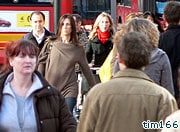A US study has found that 1.7 per cent of Americans identify themselves as homosexual, in findings that echo recent official figures in the UK which revealed that just one adult in 100 is a homosexual.
The findings from the UK were far lower than the figures the Government had previously used, raising concerns over the high levels of public money being poured into pro-homosexual policies.
The US study, conducted by the Williams Institute at UCLA in California, cross-referenced five national and state surveys.
Claims
Researchers found 1.8 per cent of respondents identified themselves as bisexual and 0.3 per cent said they were transgender.
Last September a survey carried out by the Office for National Statistics (ONS), which analysed the responses of almost 450,000 adults in the UK, showed that just one per cent of the nation’s population were homosexuals, and just 0.5 per cent were bisexuals.
Researchers had previously claimed that between six and ten per cent of the population had had homosexual experiences.
Population
In 2003 the Labour Government endorsed figures from Stonewall, a homosexual campaign group, which claimed that between five and seven per cent of the adult population was homosexual.
Speaking last year, Mike Judge, Head of Communications at The Christian Institute, said: “A large amount of public money has been spent on the basis of higher figures, which have turned out to be a lie.”
And Philip Davies MP said: “An awful lot of focus in diversity issues is given to people’s sexual preference and this difference is not as widespread as believed.”
Scrutiny
The ONS survey also found that 94.8 per cent of respondents identified themselves as heterosexuals.
In October a BBC Radio Four programme, More or Less, scrutinised the accuracy of the ONS figures.
Those who believed the higher figures said the ONS numbers must be wrong. An article on the Observer website suggested that homosexuals and bisexuals may have been reluctant to reveal their sexuality to a stranger with a clipboard.
Accuracy
But the More or Less investigation gave evidence to show the accuracy of the figures.
The ONS spent three years perfecting the wording of the question to ensure they got the most accurate result.
In addition all the respondents had agreed to take part in the survey and knew beforehand the nature of the questions they would face.
Confident
Speaking on the More or Less programme Stephen Hicks, of the ONS, defended the figures.
Mr Hicks said: “The estimate we’ve produced and published last week is in line with other surveys that ask similar questions in the UK and also in line with the pilot surveys that we carried out between 2006 and 2008.
“So we’re quite confident that the estimate we have is an accurate estimate of self perceived sexual identity.”
Doubt
In the mid-20th century Professor Alfred Kinsey claimed that a staggering ten per cent of the US population identified themselves as homosexual.
Prof Kinsey interviewed thousands of men and women in the United States between 1938 and 1952, and claimed that 13 per cent of the men and 7 per cent of the women were “almost exclusively” homosexual.
However, his methods were subsequently cast into doubt.
Caution
Professor Julia Ericksen, from Temple University in America, warned that Prof Kinsey’s methods could not be used to derive an indication as to the behaviour of the population as a whole.
Prof Ericksen cautioned: “He didn’t believe in survey sampling and he was quite antagonistic towards it.”

